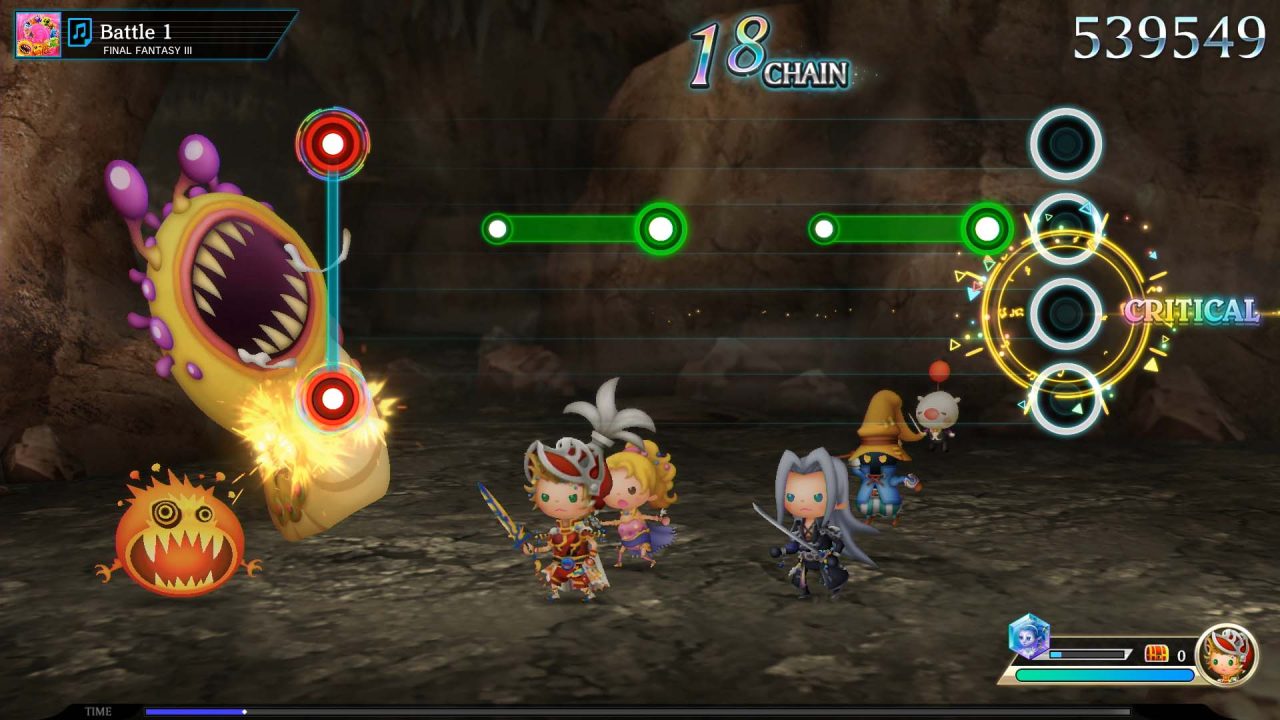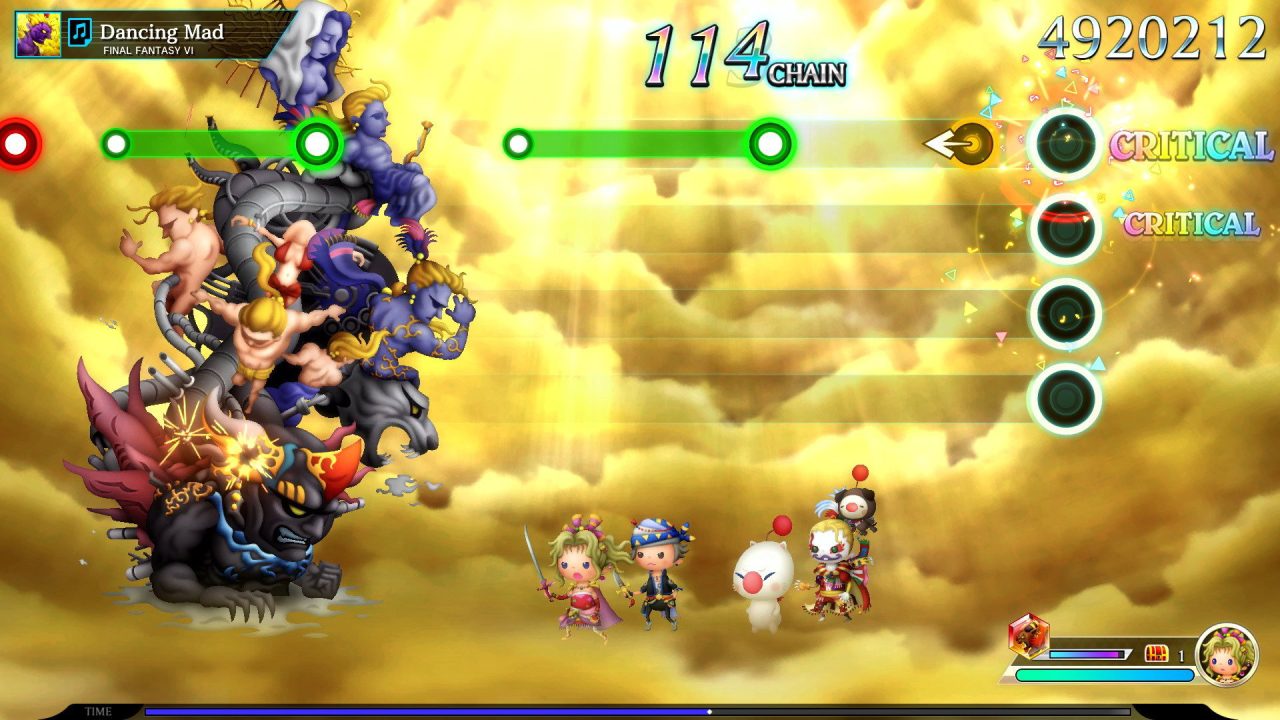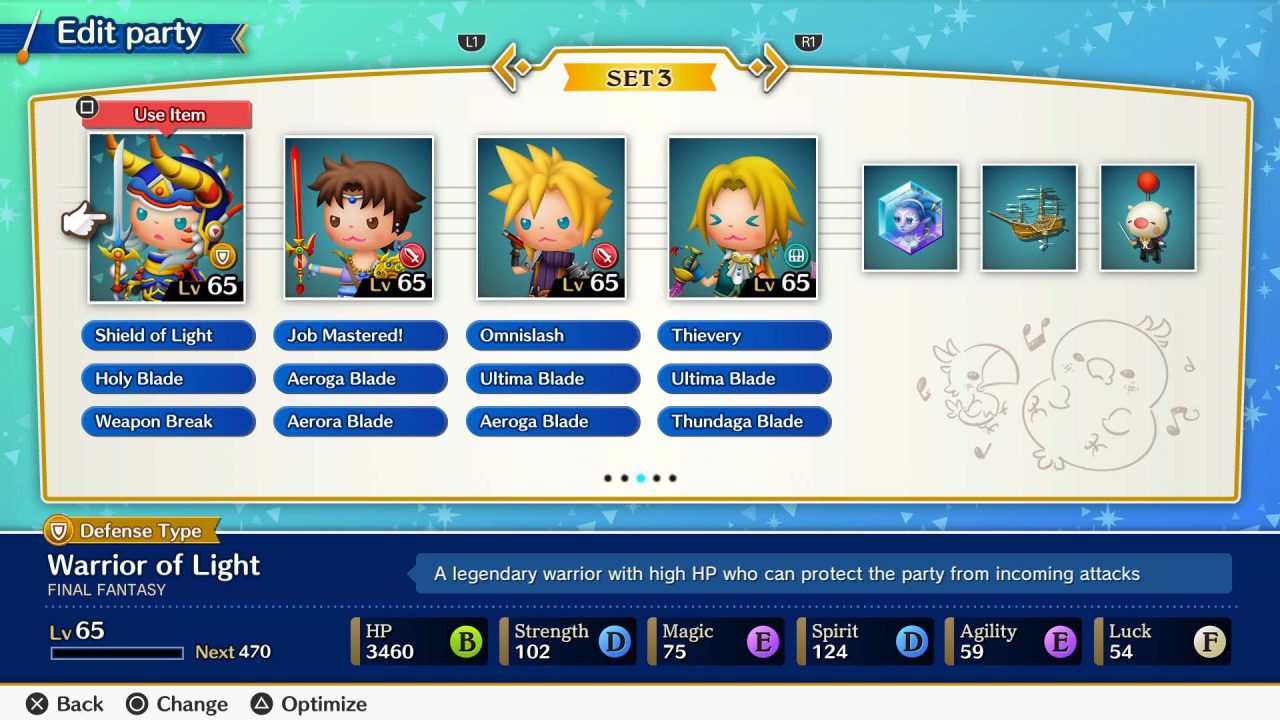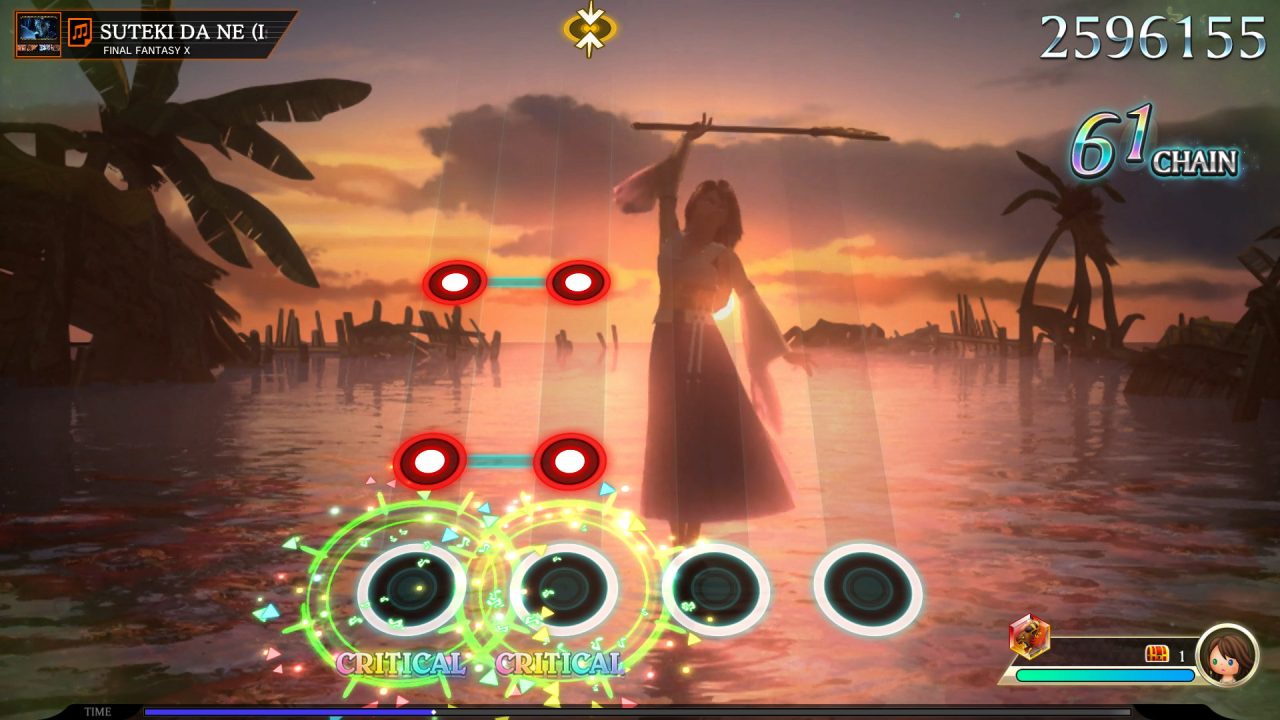Music boasts a unique capacity to tap into and influence emotions like no other medium can. If we’re downtrodden and need a friend who understands, music sits next to us. Ready to go for a jog? Music’s your energy drink. Composing art? Your muse is hand-over-hand aurally. Square—and Nobuo Uematsu—probably had no idea the legacy they were building back in 1987, but here we are in 2023, playing an entire game dedicated to the music in the Final Fantasy series.
And this isn’t even the first time. Theatrhythm Final Bar Line is the third—fourth if you include Theatrhythm Dragon Quest, which we never saw in the West—time we’re doing this. Wait, you want me to play “Troian Beauty” again? Well, yes, it’s a fantastic song worth playing again, but also because Theatrhythm Final Bar Line offers more than 380 playable songs versus Theatrhythm Curtain Call’s 221. That’s nearing double the content. But so what? The best songs are already included, and now you want me to play World of Final Fantasy music? Puh-lease.
These criticisms have merit. Similar to other series, like Madden and Smash Bros. (yes, I’m referencing Madden in an RPG review), we’re treading familiar ground. The additional songs may not be the hits, but perhaps this shows the games outside your comfort zone have some pretty good music. Also, we can play music from games outside the Final Fantasy series with the available season passes.

For those uninitiated, Theatrhythm is a celebration of music throughout core Final Fantasy titles and ancillary series. At its core, the player times button presses with notes when the colored circle overlaps the black circle at the right side of the screen. Simple stuff, right? Green lines require sustained presses, and during movement tracks (as opposed to battles), they require moving a control stick while holding down a button. Okay, getting a little spicy now. Players must flick the stick in a given direction if an arrow appears. Supreme complexity! As difficulty levels rise, the combinations can get fast and hectic, such as arrows at the end of those sustained triggers and sustained triggers coinciding with other triggers. Speed increases or decreases depending on the song, and players are graded based on points accrued through accurate timing and for sustaining a combo without missing a beat.
That’s the game. That’s why we’re here. Everything else is window dressing, but sometimes curtains can really liven up the place. Aside from timing presses, players build a party of four who they recruit by using keys to unlock game soundtracks. Eventually, players can build their favorite party. You can have your dream team of Vaan, Hope, Eiko, and Benjamin (Mystic Quest). Each character has a designated role, such as fighter, mage, support, hunter, and summoner. As you play through songs with any team of four, they gain experience points, granting them levels at a steady clip. Levels build strength and skills. Each party member has three slots, and while there’s a seemingly handy optimize feature, Final Fantasy aficionados will quickly recognize that better numbers don’t necessarily translate to a better skill. For example, I may not want my hunter to use First Strike, but instead focus on stealing items.
Items, collectible cards, and summonstones drop on occasion or become rewards for completing quests. Unlike previous titles, the items are far more streamlined and limited in variety, which is a positive feature. Potions, phoenix downs, and experience buffing items are about it. Stat-buffing items also exist, but those are used outside of songs to enhance your favorite characters. Though this is a game about timing presses—why do I care about stats?

Series Quest is the primary game mode, at least for newcomers. Those aforementioned stats will help players complete several quests in this game mode. If playing a song for song’s sake (and grade) isn’t enough incentive for you, the developers were keen enough to add seemingly arbitrary quests for each song. For instance, players may be tasked to deal 5000 damage over the course of a song, kill a specific boss within a time limit, or earn a certain score. That last example doesn’t require stats, but this is a good smattering of what players can expect. Sometimes quests even include modifying hurdles, such as bosses having double hit points or magic attacks dealing half damage. Completing these quests grants players items and trinkets, though they are by no means required to unlock songs.
Players also receive a key to unlock a game’s soundtrack after completing only a few songs within a series. Continue until you’ve had your fill or at least hit all of the soundtracks you wish to access. Unlike previous titles, this is a more linear affair. Players must start at the beginning and work their way forward. Usually, only one song is available on the road, but sometimes two or three options appear. Final Bar Line throws a lot of information at the player out of the gate without explaining everything clearly. Fortunately, once again, this game is about timing presses, so everything else is just furnishing.
Aside from items, collectible cards are just that: collectibles, but they also sometimes add stat buffs for the summon or character they represent. Summons are add-ons for your team that are cast after enough successful damage-dealing presses, though they also passively buff your team in terms of damage or experience gain.
After playing enough of the Series Quest mode, players can engage in free-play mode to play their favorite song in perpetuity, chase feats (in-game achievements), or train to beat “One-Winged Angel” on Supreme difficulty. They can also engage in multiplayer mode with a built-in rating system. Alternatively, players can play casually with nothing at stake. Players can join or host rooms with Burst Mode on or off, regardless of the rating system. Burst Mode is a chaotic assortment of abilities that trigger when players hit enough notes successfully. Fat chocobos may block the field, the triggers may decrease in size, the score can freeze for anything but a critical success, etc. Aside from that, players can see who scores best on the chosen song. Once the lobby launches, everyone can select a battle song to play, and the game chooses one of the songs randomly so that everyone’s playing the same song. Players automatically exchange profile cards and summonstones with one another. I’ve had an absolute blast playing in multiplayer with random people online. Competition can be fierce, but Burst Mode can level the playing field if you’re open to the chaos.

One more feature that breathes new life into Theatrhythm is pair mode. Here, players can play cooperatively on the couch with a friend using one controller (sharing) or two controllers. So get ready to cozy up with your beau and play “Theme of Love” together. Each player controls two halves of the lines, so you don’t have to love the music alone. In addition, pair mode is playable on the multiplayer battlefield in a sort of two vs. two test of skill. Also, this serves as a friendly reminder that you will need a PlayStation Plus subscription to play online.
So how does this all work? Is it effective? Does it warrant this console release? Let’s discuss that: this is the first Theatrhythm on a console, which matters for a couple of reasons. Primarily, the controls are hugely important. Something like Theatrhythm works exceptionally well with a stylus and a handheld that you can take roughly anywhere with some earbuds. I was worried about playing this game with a controller, but it works extremely well. Any button can activate triggers, and the sticks are readily available to navigate during field challenges and arrows. As I’ve improved and started playing higher-difficulty songs, I realized I had to change the way I hit triggers, which required me to re-learn the game in a way, but I adapted. Specifically, I prefer hitting the face buttons with my right hand, but some higher-difficulty songs require my thumb to rest on the stick, so I have become accustomed to using both shoulder buttons for triggers.
Still, losing the convenience of playing my favorite tunes on the go is a sacrifice. Of course, with this exchange comes an improvement in presentation. The PS4 release allowed us to experience the music as intended. Also, the amount of polish makes Theatrhythm pop off the screen. Yeah, this isn’t the most visually demanding game, but there’s a jolly atmosphere conveyed in a way that only a home console can execute with crisp colors and animations.

Note recognition is exceptionally forgiving, and errant presses don’t punish players. I made egregious errors multiple times, and the game continued my combo. Theorycrafting the perfect team with the right stats and abilities to tackle difficult songs is fun, but menu transitions and loading times can slow the process down. Not that the load times are exceptionally long, but everything added together clogs the piping. Accessibility is a focus in the options menu, with all sorts of ways to customize the experience for the player. Aside from expected features like color blindness options, players can personalize when successful timed presses occur. Not only can you flip a switch to tell you if you’re late or early on button presses, you can also manipulate when those successes occur.
Theatrhythm Final Bar Line is an easy grab if you’re a Final Fantasy music fan. There are more songs than ever before, and the features are cleaned up. Less is more, I think. While I enjoyed Curtain Call’s overworld map, all of the items and fussing with routes distracted from the core of what Theatrhythm should be about: the music. Having this arguably simple-looking game on a home console brings the atmosphere to life with its charming, cute art, though some may not enjoy the look and feel of the characters. Pricing might irritate some, especially those who already went all-in on previous titles, but the amount of replayability warrants the price of admission. Still, $100 for everything now and in the future can feel like a hard sell, especially if not all of the announced releases whet the palate. I have no doubt that the streamlined online experience, pair mode, and sheer quantity of music will keep me entertained for years. Also, the name suggests that this may be the last Theatrhythm, but…you know.


